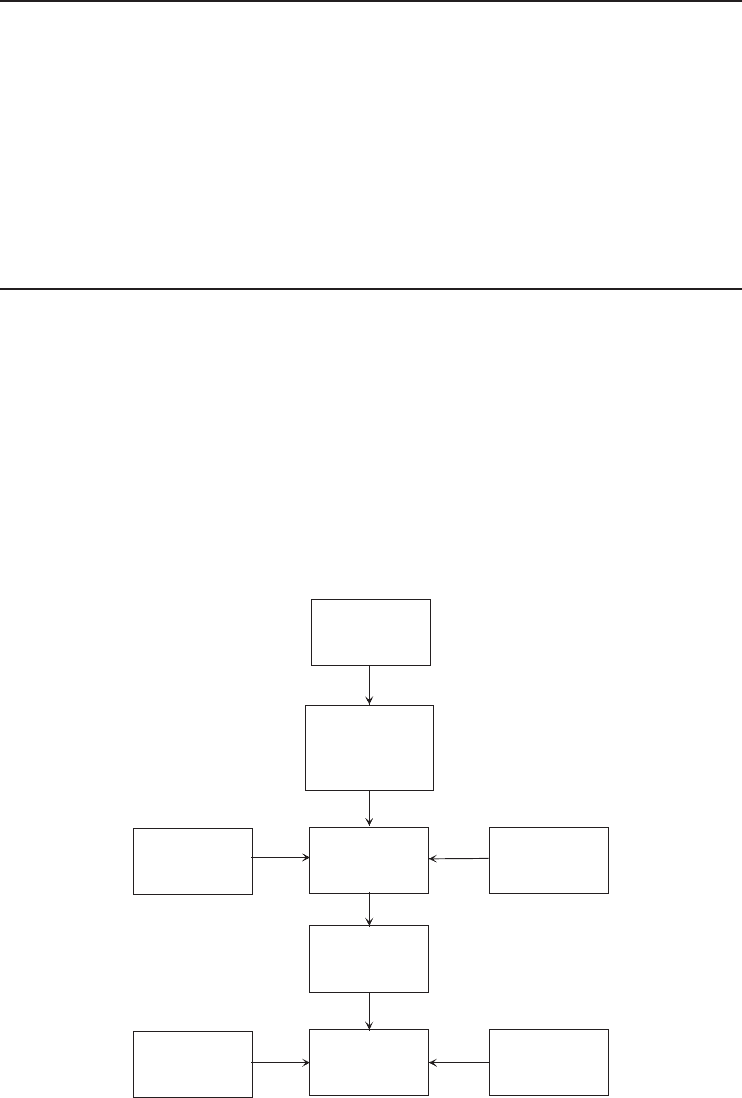Dinc Ibrahim. Refrigeration systems and applications 2th edition
Подождите немного. Документ загружается.


Heat Pipes 401
The total thermal resistance of the sink to the surroundings becomes
R
total
=
T
total
˙
Q
(7.13)
where
R
total
= R
eva
+ R
int
+ R
hp
+ R
cv
+ R
fin
+ R
air
(7.14)
or with the flux thermal resistance:
R
total
=
T
total
˙q
(7.15)
where
R
total
= R
eva
+ R
int
+ R
hp
+ R
cv
+ R
fin
+ R
air
(7.16)
In summary, the above calculation should provide a reasonable estimate on the feasibility of a
heat pipe heat sink.
7.8.1 Effective Heat Pipe Thermal Resistance
The other primary heat pipe design consideration is the effective heat pipe thermal resistance or
overall heat pipe T at a given design power. As the heat pipe is a two-phase heat-transfer device,
a constant effective thermal resistance value cannot be assigned. The effective thermal resistance is
not constant but a function of a large number of variables, such as heat pipe geometry, evaporator
length, condenser length, wick structure, and working fluid.
The total thermal resistance of a heat pipe is the sum of the resistances due to conduction through
the wall, conduction through the wick, evaporation or boiling, axial vapor flow, condensation, and
conduction losses back through the condenser section wick and wall.
The evaporator and condenser resistances are based on the outer surface area of the heat pipe.
The axial resistance is based on the cross-sectional area of the vapor space. This design guide is
only useful for powers at or below the design power for the given heat pipe.
Example 7.2
Consider a 1.27 cm diameter copper/water heat pipe. It is 30.5 cm long with a 1 cm diameter vapor
space. Assume that the heat pipe is dissipating 75 W with a 5 cm evaporator and a 5 cm condenser
length (for details, see Garner, 1996). Determine the total temperature drop.
Solution
The evaporator heat flux equals the power divided by the heat input area:
˙q
evap
=˙q
cond
=
˙
Q
A
evap
=
˙
Q
πDL
=
75 W
π(1.27 cm)(5 cm)
= 3.76 W/cm
2
The axial heat flux equals the power divided by the cross-sectional area of the vapor space:
˙q
axial
=
˙
Q
A
axial
=
˙
Q
πD
2
/4
=
75 W
π(1cm)
2
/4
= 95.5W/cm
2

402 Refrigeration Systems and Applications
For a copper/water heat pipe with a powder metal wick structure, thermal resistance at the
evaporator and condenser can be taken as 0.2
◦
C/W · cm
2
and the axial resistance for the vapor
space can be taken as 0.02
◦
C/W · cm
2
. Then, the total temperature drop may be determined based
on Equation 7.15 as
T
total
=˙q
evap
R
evap
+˙q
axial
R
axial
+˙q
cond
R
cond
= (3.76 W/cm
2
)(0.2
◦
C/W · cm
2
) + (95.5W/cm
2
)(0.02
◦
C/W · cm
2
)
+(3.76 W/cm
2
)(0.2
◦
C/W · cm
2
)
= 3.4
◦
C
7.9 Design and Manufacture of Heat Pipes
The design and manufacture of heat pipes is an extremely complex process, as shown in Figure 7.13,
involving many different physical variables such as size, shape, weight, and volume; thermophys-
ical properties such as working fluid, wicking structure, and case material properties; and other
design aspects, such as thermal load, transport length, evaporator/condenser length, acceptable tem-
perature drop, operating temperature range, gravitational environment, source–sink interfaces, fluid
inventory, life/reliability, and safety (Peterson, 1994).
In addition to these specific areas, the design and manufacture of heat pipes is governed by three
operational considerations: the effective operating temperature range, which is determined by the
Problem
specifications
Selection of
fluids
materials
wick structures
Design
theory
procedure
Optional
solutions
Evaluation
procedure
Evaluation
criteria
Optimum
solution
Fluid and
material
properties
Wick
properties
Figure 7.13 Heat pipe design flow chart (adapted from Peterson, 1994).

Heat Pipes 403
selection of the working fluid; the maximum power the heat pipe is capable of transporting, which
is determined by the ultimate pumping capacity of the wick structure (for the capillary wicking
limit); and the maximum evaporator heat flux, which is determined by the point at which nucleate
boiling occurs.
Because, as illustrated in Figure 7.13, all three of these operational considerations must be
included. The design process first requires that the design specifications for the problem under
consideration be clearly identified. Once this has been accomplished, preliminary selection of the
working fluid, wicking structure, and case materials can be performed. Finally, using an iterative
process, various combinations of working fluids, evaporator and condenser sizes, and case/wick
material combinations can be evaluated. While experience is extremely helpful, the new designer
can, using the guidelines outlined above, develop an improved, if not optimal, design. Perhaps
the most difficult part of the design process is determining how the various components utilized
in heat pipe and thermosiphon construction affect the different design requirements. Table 7.2
presents a matrix which gives some indication of how each of the three primary components – the
Table 7. 2 Heat pipe components and their effect on design requirements.
Design Requirements Working Fluid Wick Material Case Material
Thermal performance
• Transport capacity
• Operating temperature range
• Temperature drop
SF SF WF
SF WF WF
MF WF WF
Mechanical
• Physical requirements (size, weight, etc.)
• Wall thickness (internal pressure)
• Sink-source interface
• Dynamic/static loads
WF WF MF
WF NF SF
NF NF SF
WF SF MF
Reliability and safety
• Material compatibility
• External corrosion
• Fabrication
• Pressure containment/leakage
• Toxicity
SF SF SF
NF NF –
MF MF MF
WF MF SF
SF WF WF
Gravitational environment
• >1g
• 1g
• <1g
SF SF SF
MF MF WF
WF MF WF
SF: strong factor; MF: moderate factor; WF: weak factor; NF: negligible factor.
Source: Peterson (1994).

404 Refrigeration Systems and Applications
working fluid, wick material, and heat pipe case material – affect the various design requirements.
As shown, no single component appears to be more important than any other, and very few design
requirements are affected by only one of these three components.
There are many factors to consider when designing a heat pipe, including
• compatibility of materials,
• operating temperature range,
• diameter,
• power limitations,
• thermal resistances, and
• operating orientation.
However, the design issues are reduced to two major considerations by limiting the selection to
copper/water heat pipes for cooling electronics. Considerations are the amount of power that the
heat pipe is capable of carrying and its effective thermal resistance.
There are three properties of wicks that are important in heat pipe design (Faghri, 1995):
• Minimum capillary radius. This parameter should be small if a large capillary pressure differ-
ence is required, such as in terrestrial operation for a long heat pipe with the evaporator above
the condenser or in cases where a high heat transport capability is needed.
• Permeability. Permeability is a measure of the wick resistance to axial liquid flow. This param-
eter should be large in order to have a small liquid pressure drop and therefore higher heat
transport capability.
• Effective thermal conductivity. A large value for this parameter gives a small temperature drop
across the wick, which is a favorable condition in heat pipe design.
A high thermal conductivity and permeability and a low minimum capillary radius are somewhat
contradictory properties in most wick designs. For example, a homogeneous wick may have a small
minimum capillary radius and a large effective thermal conductivity, but have a small permeability.
Therefore, the designer must always make trade-offs between these competing factors to obtain an
optimal wick design.
Some heat pipes material-related issues investigated during the past decade include liquid–solid
wetting and surface phenomena, fluid container compatibility, wick development, and protection of
heat pipes from the surrounding conditions.
The most important heat pipe design consideration is the amount of power the heat pipe is capable
of transferring. Heat pipes can be designed to carry a few watts or several kilowatts, depending on
the application. Heat pipes can transfer much higher powers for a given temperature gradient than
even the best metallic conductors. If driven beyond its capacity, however, the effective thermal
conductivity of the heat pipe will be significantly reduced. Therefore, it is important to assure that
the heat pipe is designed to safely transport the required heat load.
The maximum heat transport capability of the heat pipe is governed by several limiting factors
which must be addressed when designing a heat pipe. There are five primary heat pipe heat transport
limitations. These heat transport limits, which are a function of the heat pipe operating temperature,
include viscous, sonic, capillary pumping, entrainment or flooding, and boiling. Each heat transport
limitation is summarized in Table 7.3.
7.9.1 The Thermal Conductivity of a Heat Pipe
Heat pipes do not have a set thermal conductivity like solid materials because of the two-phase
heat transfer. Instead, the effective thermal conductivity improves with length. For example, a

Heat Pipes 405
Table 7. 3 Heat pipe heat transport limitations.
Heat
Transport
Limit
Description Cause Potential Solution
Viscous Viscous forces prevent vapor
flow in the heat pipe
Heat pipe operating
below recommended
operating temperature
Increase heat pipe operating
temperature or find alternative
working fluid
Sonic Vapor flow reaches sonic velocity
when exiting heat pipe
evaporator, resulting in a constant
heat pipe transport power and
large temperature gradients
Power–temperature
combination, too much
power at low operating
temperature
This is typically only a
problem at start-up. The heat
pipe will carry a set power
and the large T will
self-correct as the heat pipe
warms up
Entrainment/
Flooding
High-velocity vapor flow
prevents condensate from
returning to evaporator
Heat pipe operating
above designed power
input or at too low an
operating temperature
Increase vapor space diameter
or operating temperature
Capillary Sum of gravitational, liquid, and
vapor flow pressure drops exceed
the capillary pumping head of the
heat pipe wick structure
Heat pipe input power
exceeds the design heat
transport capacity of the
heat pipe
Modify heat pipe wick
structure design or reduce
power input
Boiling Film boiling in heat pipe
evaporator typically initiates at
5–10 W/cm
2
for screen wicks and
20–30 W/cm
2
for powder metal
wicks
High radial heat flux
causes film boiling
resulting in heat pipe
dry out and large
thermal resistances
Use a wick with a higher heat
flux capacity or spread out
the heat load
Source: Garner (1996) (Reproduced by permission of Flomerics, Inc.).
10-cm-long heat pipe carrying 100 W will have close to the same thermal gradient as a 12-in.
(30 cm)-long pipe carrying the same power. Thus, the 12-in. pipe would have a higher effective
thermal conductivity. Unlike solid materials, a heat pipe’s effective thermal conductivity will also
change with the amount of power being transferred and with the evaporator and condenser sizes.
For a well-designed heat pipe, effective thermal conductivity can range from 10 to 10,000 times
the effective thermal conductivity of copper depending on the length of the heat pipe.
7.9.2 Common Heat Pipe Diameters and Lengths
Some heat pipes are intentionally made easy to bend. Many heat pipes are made of annealed copper.
These units can be readily bent and formed to fit customer applications. The most common heat
pipe diameters in current production are 2, 3, 4, and 6 mm and 1/4 (6.4 mm) and 5/8 in. (17.9 mm)
in diameter. Lengths vary with the diameter from about 12 in. (30 mm) for 2-mm diameter units to
about 4 ft (1.2 m) for 5/8-in. (17.9 mm) diameter units.
Heat pipes are manufactured in a multitude of sizes and shapes. Unusual application geometry
can be easily accommodated by the heat pipe’s versatility to be shaped as a heat transport device.
If some range of motion is required, heat pipes can even be made of flexible material. Two of the
most common heat pipes are constant temperature (the heat pipe maintains a constant temperature
or temperature range) and diode (the heat pipe allows heat transfer in only one direction).

406 Refrigeration Systems and Applications
7.10 Heat-Transfer Limitations
There are various parameters that put limitations and constraints on the steady and transient oper-
ation of heat pipes. In other words, the rate of heat transport through a heat pipe is subject to a
number of operating limits. The following physical phenomena might limit heat transport in heat
pipes (Faghri, 1995):
• Capillary limit. For a given capillary wick structure and working fluid combination, the pumping
ability of the capillary structure to provide the circulation for a given working medium is limited.
This limit is usually called the capillary or hydrodynamic limit.
• Sonic limit. For some heat pipes, especially those operating with liquid metal working fluids, the
vapor velocity may reach sonic or supersonic values during the start-up or steady state operation.
This choked working condition is called the sonic limit.
• Boiling limit. If the radial heat flux or the heat pipe wall temperature becomes excessively high,
boiling of the working fluid in the wick may severely affect the circulation of the working fluid
and lead to the boiling limit.
• Entrainment limit. When the vapor velocity in the heat pipe is sufficiently high, the shear force
existing at the liquid–vapor interface may tear the liquid from the wick surface and entrain it
into the vapor flow stream. This phenomenon reduces the condensate return to the evaporator
and limits the heat transport capability.
• Frozen start-up limit. During the start-up process from the frozen state, vapor from the evapo-
ration zone may be refrozen in the adiabatic or condensation zones. This may deplete the working
fluid from the evaporation zone and cause dryout of the evaporator.
• Continuum vapor limit. For small heat pipes, such as micro heat pipes, and for heat pipes with
very low operating temperatures, the vapor flow in the heat pipe may be in the free molecular
or rarefied condition. The heat transport capability under this condition is limited because the
continuum vapor state has not been reached.
• Vapor pressure limit (viscous limit). When the viscous forces dominate the vapor flow, as for
a liquid metal heat pipe, the vapor pressure at the condenser end may reduce to zero. Under
this condition the heat transport of the heat pipe may be limited. A heat pipe operating at
temperatures below its normal operating range can encounter this limit, which is also know as
the vapor pressure limit.
• Condenser heat-transfer limit. The maximum heat rate capable of being transported by a heat
pipe may be limited by the cooling ability of the condenser. The presence of noncondensible
gases can reduce the effectiveness of the condenser.
The heat-transfer limitation can be any of the above limitations, depending on the size and shape
of the pipe, working fluid, wick structure, and operating temperature. The lowest limit among the
eight constraints defines the maximum heat transport limitation of a heat pipe at a given temperature.
Although heat pipes are very efficient heat-transfer devices, they are subject to a number of
heat-transfer limitations. These limitations determine the maximum heat-transfer rate a particular
heat pipe can achieve under certain working conditions. The type of limitation that restricts the
operation of the heat pipe is determined by the limitation which has the lowest value at a specific
heat pipe working temperature.
7.11 Heat Pipes in HVAC
The common practice in air conditioning was to design equipment basically to cool the air. However,
the human body actually responds to additional factors other than temperature. To provide truly
comfortable conditions, we must control humidity. Overlooking this aspect, in many instances we

Heat Pipes 407
have produced environments which are cold, clammy, stuffy, and even unhealthy. The heat pipe in
this regard appears to be an effective solution to overcome such problems.
In HVAC applications, a heat pipe is a simple device that can transfer heat from one point to
another without having to use an external power supply. It is a sealed tube that has been partially
filled with a vaporizable working fluid (such as alcohol or a freon, e.g., R-22) from which all air
has been evacuated. The sealed refrigerant, which will boil under low-grade heat, absorbs heat
from the warm return air such as in an air-conditioning system and vaporizes inside the tube. The
vapor then travels to the other end of the heat pipe (the high end), which is placed in the stream
of cold air that is produced by the air conditioner. In most cases, on the inside wall of the pipe, a
wicking material transports the liquified fluid by capillary action. The heat that was absorbed from
the warm air at the low end is now transferred from the refrigerant’s vapor through the pipe’s wall
into the cool supply air. This loss of heat causes the vapor inside the tube to condense back into
a fluid. The condensed refrigerant then travels by gravity to the low end of the heat pipe where it
begins the cycle all over again.
Serious work on heat pipes began in the 1960s with applications of heat pipes in the space
program. The largest amount of research was done in the United States by NASA, with heat pipes
earning a place in the domain of aerospace applications. Only recently have heat pipes been applied
to HVAC (Dinh, 1996). The application of heat pipes for heat recovery in cold climates is widely
recognized. In northern Europe and Canada, heat recovery with heat pipes has proven itself to
be very reliable and economical. With advancement of heat pipes with a low air pressure drop,
made possible by loop configurations, heat recovery applications can now be extended to milder
climates and still be economical. A new possibility is cooling recovery in summertime, which is now
economical enough to be considered. The application of heat pipes to increase the dehumidification
capacity of a conventional air conditioner is one of the most attractive applications. By using
dehumidifier heat pipes, one can decrease the relative humidity in the conditioned space (typically
by 10%) resulting in noticeably improved indoor air quality and reduced power demand. Heat pipes
also promise to improve indoor air quality greatly and at the same time help conserve energy.
Heat pipes provide a large number of benefits in HVAC applications, including
• improved comfort level,
• reduced moisture and better humidity control,
• higher productivity,
• improved air quality,
• easy retrofitting of existing systems,
• no moving parts,
• no additional energy for operation,
• dramatic reduction in HVAC loads and hence energy and money savings,
• low payback time,
• less maintenance costs, and
• less installation costs.
7.11.1 Dehumidifier Heat Pipes
As mentioned earlier, heat pipes can dramatically improve the moisture removal capabilities of
many air-conditioning systems. Air can be precooled by simply transferring heat from the warm
incoming air to the cool supply air (Figure 7.14). This “bypassing” can be accomplished by placing
the low end of a heat pipe in the return air and the high end in the supply air. Heat is removed from
the warm upstream air and rerouted to the cool downstream air. This heat, in effect, bypasses the
evaporator, although the air that contained the heat does indeed pass through the air-conditioning
coil. The total amount of cooling required is slightly reduced and some of the air conditioner’s

408 Refrigeration Systems and Applications
Precool
Reheat
Heat pipe
Heat pipe
Cooling coil
Increased condensate
Warm and
humid
Precooled
Over
cooled
Dry and
comfortable
Figure 7.14 Heat pipe system for dehumidification (Courtesy of Heat Pipe Technology, Inc.).
sensible capacity is therefore exchanged for additional latent capacity. Now the unit can cope with
high-moisture air more efficiently. To accomplish a heat transfer around a cooling coil through
utilization of heat pipe technology, different configurations may be used. One method is to arrange
several heat pipes in parallel banks with the evaporator coil separating the pipes’ evaporator ends
and condenser ends. Fins (much like those found in air conditioner coils) may then be attached to
the outside surface of the heat pipes to improve the heat transfer between the tubes and the air.
Nowadays, libraries, restaurants, storage facilities, and supermarkets benefit the most from heat
pipe technology that needs moisture-controlled air to preserve goods and products kept inside, to
prevent the increased wear and tear associated with high humidity, or to increase occupant comfort.
Any air-conditioning system that uses reheat, desiccants, or mechanical dehumidification is a good
candidate for heat pipe assistance.
When reheat is used, the energy savings that can be accomplished through heat pipe dehumid-
ification assistance can be substantial. While the percentage of energy savings may vary greatly
from customer to customer because of the number of variables, one of the best examples reported
so far involves a chain restaurant that was retrofitted with heat pipes. A restaurant was selected for
the test because restaurants have traditionally been victimized by extremely humid interior condi-
tions. High humidity causes interior fixtures and building materials to deteriorate at an accelerated
rate because of water condensation. High humidity also results in increased energy and equipment
repair/replacement costs. In addition to the geographic location, the elements that contribute to
high humidity in restaurants include customer loads, cooking loads, and code requirements con-
cerning the rate of movement of outside air to the building’s interior. Analysis of data from the
test site indicated that outside air requirements can be a key causative factor of extremely high
interior humidity.
7.11.1.1 Working Principle
The working principle of the heat pipe for dehumidification in an air-conditioning system is quite
simple. The heat pipe performs heat transfer between the warm return air from the room to the
cold supply air from the air-conditioning coil. In the operation, heat pipes may be described as
having two sections: precool and reheat (Figure 7.14). The first section is located in the incoming

Heat Pipes 409
air stream. When warm air passes over the heat pipes, the refrigerant vaporizes, carrying heat to the
second section of heat pipes, placed downstream. Because some heat has been removed from the
air before encountering the evaporator coil, the incoming air stream section is called the precool
heat pipe. Air passing through the evaporator coil is brought down to a lower temperature, resulting
in greater condensate removal. The “overcooled” air is then reheated to a comfortable temperature
by the reheat heat pipe section, using the heat transferred from the precool heat pipe. This entire
process of precool and reheat is accomplished with no additional energy use. The result is an
air-conditioning system with the ability to remove 50–100% more moisture than regular systems.
With advantages such as high effectiveness, low air drag, moderate cost, and no cross contami-
nation, heat pipes offer a perfect solution to humidity-related internal air quality problems. When
properly applied, heat pipes can be very economical, to reduce both initial cost and operating cost.
Even in a case of retrofitting existing systems with custom built-to-fit heat pipes, the savings in
avoiding reheat can pay for the heat pipe installation within a few years. From the mechanical
integrity and maintenance standpoint heat pipes, having no moving parts, are expected to outlast
other components of the HVAC system. As with any coil, periodic cleaning should keep heat
pipes working at peak efficiency. Corrosive atmospheres can be handled by coating heat pipes with
corrosion-prevention plastic coatings (Dinh, 1996).
7.11.1.2 Indoor Dehumidifier Heat Pipes
Indoor air quality is improved by using heat pipes in the air-conditioning system (Figure 7.15),
creating a situation of enhanced comfort, greater health, elimination of mold and mildew, and
reduction of building deterioration.
Energy saving through the use of heat pipes is achieved in the following ways:
• by the elimination of reheat and the additional air-conditioning load imposed by the reheat and
• by setting the thermostat a few degrees higher to achieve the same comfort level because of the
lower relative humidity.
100% stainless
steel cabinet
Exclusive polymer corrosion
protection
Integral dehumidifier heat pipe
High efficiency 2" plated
filters
Stainless steel condensate
drain pan
Oversized filter drier
Receiver/accumulator
High efficiency
scroll compressor
Fully enclosed
electrical box
Direct drive heavy
duty driver
25% Fresh air capable
Figure 7.15 An indoor dehumidifier with heat pipes (Courtesy of Heat Pipe Technology Inc.).

410 Refrigeration Systems and Applications
7.11.2 Energy Recovery Heat Pipes
• Heat pipes offer a highly efficient way to recover energy from a building’s exhaust air and reuse
that same energy to precool or preheat incoming fresh air without having to use an external power
supply. Heat pipes are most commonly installed to control humidity in hot, humid climates and
as air preheaters in steam boilers, air dryers, waste heat recovery from exhaust steam, and waste
heat recovery from conditioned air.
• Heat pipes are most cost-effective when the air streams are adjacent. Within the heat pipe,
a charge of refrigeration continuously evaporates, condenses, and migrates by capillary action
through the porous wick. Since the only thing that moves is the refrigerant, and it is self-contained,
low maintenance and long life are obtained. These self-contained, no-moving-part devices have
many applications. The example shown here is sensible heat transfer between adjacent fresh-
air-intake and stale exhaust air streams. When the two air streams are farther apart, a set of
individual coils and circulating heat-transfer fluid connecting them provides simple heat transfer,
with no restrictions on exhaust and intake location. Energy transfer wheels go even further than
run-around coils and heat pipes, in that they can control both temperature and humidity. In winter,
they recover both sensible and latent heat from exhaust air; in summer, they can both cool and
dehumidify the incoming fresh air. Seals and laminar flow of air through the wheels reduce the
mixing of exhaust air and incoming air. A further precautionary step in the process purges each
sector of the wheel briefly, using fresh air to blow away any unpleasant residual effects of the
exhaust air on the wheel surfaces. These systems are much more maintenance prone and may
not be as cost-effective as the heat pipe.
In conjunction with the above introductory information, energy (heat) recovery heat pipes (e.g.,
Figures 7.16 and 7.17) provide economical and reliable recovery of both heat and cooling. Here,
the heat pipe is assembled into arrays (bundles of tubes). The bundle of finned heat pipes extends
through the wall separating the inlet and exhaust ducts in a pattern that resembles conventional
finned coil heat exchangers. Each of the separate pipes, however, is a sealed element consisting of
an annular wick on the inside of the full length of the tube, in which an appropriate heat-transfer
fluid is absorbed. The heat transferred from the hot exhaust gases evaporates the fluid in the wick,
causing the vapor to expand into the core of the heat pipe. The latent heat of vaporization is carried
Figure 7.16 An energy recovery heat pipe (Courtesy of Heat Pipe Technology, Inc.).
